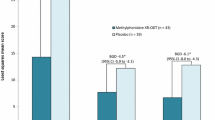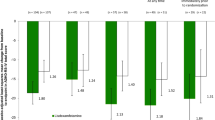Abstract
Attention-deficit hyperactivity disorder (ADHD) is the most common psychiatric disorder in children. Currently, the most widely prescribed therapy for ADHD is methylphenidate. Several formulations of methylphenidate have been developed that modify the delivery of the drug into the body. These include immediate-release (IR) tablets and modified-release preparations including sustained-release tablets, controlled-delivery capsules and tablets, and transdermal delivery systems. The IR tablet is taken two or three times daily and has been demonstrated to show efficacy through its rapid onset of action. The modified-release formulations deliver methylphenidate at a controlled rate and are administered once daily; they were developed to mimic the efficacy of the IR tablet by controlling drug release. The latest formulation development efforts have been directed towards combining the rapid release and onset of action of an IR component with an extended-release component that would maintain drug levels and allow for once-daily administration.
The rationale for the development of various delivery systems of methylphenidate stems from the need for drug coverage for at least 8 hours for ADHD patients. This would maintain efficacy over the entire school day and would eliminate the need for repeated administrations while the patient was at school. Early formulation development targeted a constant-release profile or an apparent zero-order input with the intention of maintaining plasma drug levels at a constant level for the required time period. However, it was demonstrated that the constant delivery of methylphenidate did not provide equivalent efficacy to the repeated administration of the IR product over the school day and resulted in tolerance to the effects of the drug. This suggested that sustained-release formulations that maintained constant drug levels over the treatment period would not result in the optimal therapeutic condition. In contrast, a drug delivery profile that maintained a drug release pattern with increase-release kinetics would be able to overcome the tolerance that was observed with the constant delivery formulations. Therefore, the formulation development for modified-release once-daily administration products of methylphenidate has been targeted to mimic the repeated administrations of IR methylphenidate.



Similar content being viewed by others
Notes
The use of trade names is for product identification purposes only and does not imply endorsement.
References
Wender PH, Wolf LE, Wasserstein J. Adults with ADHD: an overview. Ann N Y Acad Sci 2001; 931: 1–16
Physicans’ Desk Reference®. 53rd ed. Montvale (NJ): Medical Economics Co, 1999: 2078–9
Smucker WD, Hedayat M. Evaluation and treatment of ADHD. Am Fam Physician 2001; 64: 817–29
Stein MA, Blondis TA, Schnitzler ER, et al. Methylphenidate dosing: twice daily versus three times daily. Pediatrics 1996; 98(4): 748–56
Patrick KS, Straughn AB, Jarvis EJ, et al. The absorption of sustained-release methylphenidate formulations compared to an immediate release formulation. Biopharm Drug Dispos 1989; 10: 165–71
Solanto MV, Conner CK. A dose-response and time-action analysis of autonomic and behavioral effects of methylphenidate in attention deficit disorder with hyperactivity. Psychophysiology 1982; 19: 658–67
Swanson J, Gupta S, Lam A, et al. Development of a new once-a-day formulation of methylphenidate for the treatment of attention-deficit/hyperactivity disorder. Arch Gen Psychiatry 2003; 60: 204–11
Swanson JM, Kinsbourne M, Roberts W, et al. Time-response analysis of the effect of stimulant medication on the learning ability of children referred for hyperactivity. Pediatrics 1978; 61: 21–9
Srinivas NR, Hubbard JW, Quinn D, et al. Enantioselective pharmacokinetics and pharmacodynamics of dl-threo-methylphenidate in children with attention deficit hyperactivity disorder. Clin Pharmacol Ther 1992; 52: 561–8
Srinivas NR, Hubbard JW, Korchinski ED, et al. Enantioselective pharmacokinetics of dl-threo-methylphenidate in humans. Pharm Res 1993; 10: 14–21
Modi NB, Lindemulder B, Gupta SK. Single and multiple-dose pharmacokinetics of an oral once-a-day osmotic controlled-release OROS® (methylphenidate HC1) formulation. J Clin Pharmacol 2000; 40: 379–88
Gonzalez MA, Pentikis HS, Anderl N, et al. Methylphenidate bioavailability from two extended-release formulations. Int J Clin Pharmacol Ther 2002; 40: 175–84
Pentikis H, Simmons RD, Benedict M, et al. Methylphenidate bioavailability in adults following an extended-release multiparticulate formulation administered sprinkled or as an intact capsule. J Am Acad Child Adolesc Psychiatry 2002; 41(4): 443–9
Modi NB, Wang B, Hu WT, et al. Effect of food on the pharmacokinetics of osmotic controlled-release methylphenidate HC1 in healthy subjects. Biopharm Drug Dispos 2000; 21: 23–31
Modi NB, Wang B, Noveck RJ, et al. Dose-proportional and stereospecificc pharmacokinetics of methylphenidate delivered using an osmotic, controlled-release oral delivery system. J Clin Pharmacol 2000; 40: 1141–9
Meyer MC, Straugh AB, Jarvi EJ, et al. Bioequivalence of methylphendiate immediate-release tablets using a replicated study design to characterize in-trasubject variability. Pharm Res 2000; 17: 381–4
Dzerk AM, Briscoe CJ, Wheling MR, et al. Stereoselective determinations of methylphenidate and ritalinic acid in human plasma by a sensitive LC/MS/MS method to support pharmacokinetic studies [poster]. Annual Meeting of the American Association of Pharmaceutical Scientists; 1999 Nov 14–18; New Orleans. Arlington (VA): American Association of Pharmaceutical Scientists, 1999
Roland M, Tozer TN. Clinical pharmacokinetics: concepts and applications. Philadelphia: Lea and Febiger, 1989
Swanson JM, Gupta S, Guinta D, et al. Acute tolerance to methylphenidate in the treatment of attention deficit hyperactivity disorder in children. Clin Pharmacol Ther 1999; 66: 295–305
Swanson JM, Gupta S, Williams L, et al. Efficacy of a new pattern of delivery of methylphenidate for the treatment of ADHD: effects on activity level in the classroom and on the playground. J Am Acad Child Adolesc Psychiatry 2002; 41: 1306–14
Ritalin® [prescribing information]. East Hanover (NJ): Novartis, 2003
Wargin W, Patrick K, Kilts C, et al. Pharmacokinetics of methylphenidate in man, rat, and monkey. J Pharmacol Exp Ther 1983; 226: 382–6
Hungund BL, Perel JM, Hurwic MJ, et al. Pharmacokinetics of methylphenidate in hyperkinetic children. Br J Clin Pharmacol 1979; 8: 571–6
Elia J, Ambrosini PL, Rapoport JL. Treatment of attention deficit hyperactivity disorder. N Engl J Med 1999; 340: 780–8
Hubbard JW, Srinivas NR, Quinn D, et al. Enantioselective aspects of the disposition of dl-threo-methylphenidate after the administration of a sustained-release formulation to children with attention deficity-hyperactivity disorder. J Pharm Sci 1989; 78(11): 944–7
Birmaher B, Greenhill LL, Cooper TB, et al. Sustained release methylphenidate: pharmacokinetic studies in ADDH males. J Am Acad Child Adolesc Psychiatry 1989; 28(5): 768–71
Pelham WE, Sturges J, Hoza J, et al. Sustained-release and standard methylphenidate effects on cognitive and social behavior in children with attention deficit disorder. Pediatrics 1987; 80: 491–501
Brown GL, Ebert MH, Mikkelson EJ, et al. Behavior and motor activity response in hyperactive children and plasma amphetamine levels following a sustained release preparation. J Am Acad Child Psychiatry 1980; 19: 225–39
Gualtieri CT, Wargin W, Kanoy R, et al. Clinical studies of methylphenidate serum levels in children and adults. J Am Acad Child Psychiatry 1982; 21: 19–26
Gualtieri CT, Hicks RE, Patrick K, et al. Clinical correlates of methylphenidate blood levels. Ther Drug Monit 1984; 6: 379–92
Patrick KS, Mueller RA, Gualtieri CT, et al. Pharmacokinetics and actions of methylphenidate. In: Meltzer HY, editor. Psychopharmacology: the third generation of progress. New York: Raven Press, 1987: 1387–95
Nies AS, Spielberg SP. Principle of therapeutics. In: Hardman JG, Gilman AG, Limbird LE, editors. Goodman and Gilman’s the pharmacological basis of therapeutics. New York: McGraw Hill, 1996: 43–75
Concerta® [prescribing information]. Mountain View (CA): Alza Corporation, 2000
Markowitz JS, Straugh AB, Patrick KS, et al. Pharmacokinetics of methylphenidate after oral administration of two modified-release formulations in healthy adults. Clin Pharmacokinet 2003; 42(4): 393–401
Keating GM, McClellan K, Jarvis B. Methylphenidate (OROS® Formulations). CNS Drugs 2001; 15(6): 495–500
Swanson JM, Lerner M, Wigal T, et al. The use of a laboratory school protocol to evaluate concepts about efficacy and side effects of new formulations of stimulant medications. J Atten Disord 2002; 6Suppl. 1: S73–88
Swanson J, Greenhill L, Pelham W, et al. Initiating Concerta (OROS® methylphenidate HC1) qd in children with attention-deficit hyperactivity disorder. J Clin Res 2000; 3: 59–76
Wolraich ML, Greenhill LL, Pelham W, et al. Randomized, controlled trial of Oros® methylphenidate once a day in children with attention-deficit/hyperactivity disorder. Pediatrics 2001; 108(4): 883–92
Bierderman J, Quinn D, Wigal S, et al. Methylphenidate hydrochloride extended release capsules: once-daily therapy for ADHD [abstract no. NR334]. Annual Meeting of the American Psychiatric Association; 2002 May 18–23; Philadelphia. Arlington (VA): American Psychiatric Association, 2002
Biederman J, Quinn D, Weiss M, et al. Methylphenidate hydrochloride extended release capsules (Ritalin LA®): a new once-daily therapy for ADHD [poster]. Annual Meeting of the American Psychiatric Association; 2002 May 18–23; Philadelphia. Arlington (VA): American Psychiatric Association, 2002
Gonzalez MA, Pentikis HS, Campbell DA, et al. Methylphenidate steady-state pharmacokinetics with a once-daily transdermal system [poster]. Annual Meeting of the American Association of Pharmaceutical Scientists; 2002 Nov 8–14; Toronto. Arlington (VA): Americal Association of Pharmaceutical Scientists, 2002
Volkow ND, Swanson JM. Variables that affect the clinical use and abuse of methylphenidate in the treatment of ADHD. Am J Psychiatry 2003; 160: 1909–18
Singh P, Boniello S, Liu P, et al. Transdermal iontophoretic delivery of methylphenidate HC1 in vitro. Int J Pharm 1999; 178: 121–8
Kupietz SS, Winsberg BG, Sverd J. Learning ability and methylphenidate (Ritalin®) plasma concentrations in hyperkinetic children: a preliminary investigation. J Am Acad Child Psychiatry 1982; 21: 27–30
Winsberg BG, Kupietz SS, Sverd J, et al. Methylphenidate oral dose plasma concentrations and behavioral response in children. Psychopharmacology (Berl) 1982; 76: 329–32
Shaywitz SE, Hunt RD, Jatlow P, et al. Psychopharmacology of attention deficit disorder: pharmacokinetics, neuroendocrine, and behavioral measures following acute and chronic treatment with methylphenidate. Pediatrics 1982; 69: 688–94
Swanson JM, McBurnett K, Christian P, et al. Stimulant medications and the treatment of children with ADHD. In: Ollendick TH, Prinz RJ, editors. Advances in clinical child psychology. New York: Plenum Press, 1995: 265–322
Swanson JM, Volkow N. Pharmacokinetic and pharmacodynamic properties of methylphenidate in humans. In: Solanto MV, Arnstep AFT, Castellanos FX, editors. Stimulant drugs and ADHD: basic and clinical neuroscience. New York: Oxford University Press, 2001: 259–82
Chan YM, Swanson JM, Soldin SS, et al. Methylphenidate hydrochloride given with or without breakfast: II. Effects on plasma concentration of methylphenidate and ritalinic acid. Pediatrics 1983; 72(1): 56–9
Chan YM, Soldin SJ, Swanson JM, et al. Gas chromatographic/mass spectroscopic analysis of methylphenidate (Ritalin®) in serum. Clin Biochem 1980; 13: 266–72
Perel JM, Greenhill LL, Currant S, et al. Correlates of pharmacokinetics and attentional measures in methylphenidate treated hyperactive children. Clin Pharmacol Ther 1991; 29: 160–1
Swanson JM, Lerner M, Cantwell DP. Blood levels and tolerance to stimulants in ADDH children. Clin Neuropharmacol 1986; 9: 523–5
Pelham WE, Greenslade KE, Vodde-Hamilton M, et al. Relative efficacy of long-acting stimulants on children with attention deficit disorder: a comparison of standard methylphenidate, sustained-release methylphenidate, sustained-release dextroamphetamine, and pemoline. Pediatrics 1990; 86: 226–37
Fitzpatrick PA, Klorman R, Brumaghim JT, et al. Effects of sustained-release and standard preparations of methylphenidate in attention deficit disorder. J Am Acad Child Adolesc Psychiatry 1992; 31: 226–34
Dulcan MK. Using psychostimulants to treat behavioral disorders of children and adolescents. J Child Adolesc Psychopharmacol 1990; 1: 7–20
Acknowledgment
The authors would like to thank John Pentikis and Linda Gonzalez for their assistance in the preparation of this manuscript.
The authors have provided no information on sources of funding or on conflicts of interest directly relevant to the content of this review.
Author information
Authors and Affiliations
Corresponding author
Rights and permissions
About this article
Cite this article
Pentikis, H.S., González, M.A. Effect of formulation on methylphenidate release patterns. Am J Drug Deliv 3, 47–54 (2005). https://doi.org/10.2165/00137696-200503010-00005
Published:
Issue Date:
DOI: https://doi.org/10.2165/00137696-200503010-00005




